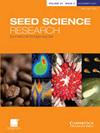Seed germination, initial growth and leaf anatomy of seedlings of four tree species grown in mine tailings in Brazil
IF 1.9
3区 生物学
Q2 PLANT SCIENCES
引用次数: 1
Abstract
The objective of this study was to test the tolerance of two species of Schinus and two species of Handroanthus cultivated in iron mining tailings from the rupture of the dam in Mariana, Brazil. Samples of mining tailings were collected 1 km away from the dam location and then dried, stored in plastic bags and further analysed for elemental composition. The seeds, later seedlings, were cultivated in the mining waste and in sand in two experiments separately and the experimental design was in a 2 × 3 factorial scheme (two substrates and three combinations of species), with six replications (n = 36). After 60 d of the establishment of the experiments, the germination data, biometric and anatomical measurements of the leaves were evaluated, in addition to the elemental characterization of the tailings. Mining tailings showed macro and micronutrients in addition to potentially toxic elements (As, Al, Cr, Pb and Ni). Seeds germinated and seedlings survived in the mining tailings. Mining tailings reduced the seedling emergence in Handroanthus, whereas it increased the emergence in S. molle and had no significant effect in S. terebinthifolia. Mining tailings reduced the number and length of roots in Schinus but increased these traits in Handroanthus species. Moreover, mining tailings reduced the fresh mass in Handroanthus but had no effect in the Schinus species. Mining tailings reduced the palisade and spongy parenchyma Handroanthus but only the spongy parenchyma was reduced in Schinus species. Therefore, mining tailings provided conditions for seed germination and seedling growth and Schinus species showed higher tolerance.巴西矿山尾矿中生长的四种树种种子萌发、初期生长和叶片解剖
本研究的目的是测试在巴西马里亚纳大坝决堤的铁矿尾矿中培养的两种Schinus和两种Handroanthus的耐受性。在距离坝址1公里处采集尾矿样本,然后干燥,储存在塑料袋中,并进一步分析元素成分。种子,后来的幼苗,分别在两个实验中在采矿废料和沙子中培养,实验设计采用2×3因子方案(两种基质和三种物种组合),共有六次重复(n=36)。在建立实验60天后,除了尾矿的元素特征外,还对叶片的发芽数据、生物特征和解剖测量进行了评估。尾矿中除了含有潜在的有毒元素(As、Al、Cr、Pb和Ni)外,还含有大量和微量元素。种子在尾矿中发芽,幼苗存活下来。尾矿的开采降低了Handroanthus的出苗率,而增加了S.molle的出苗率。尾矿的开采减少了Schinus根系的数量和长度,但增加了Handroanthus物种的这些特征。此外,尾矿的开采降低了番红花的新鲜质量,但对Schinus物种没有影响。尾矿减少了刺桐的栅栏和海绵状薄壁组织,但只有海绵状薄壁细胞减少。因此,尾矿为种子发芽和幼苗生长提供了条件,Schinus物种表现出更高的耐受性。
本文章由计算机程序翻译,如有差异,请以英文原文为准。
求助全文
约1分钟内获得全文
求助全文
来源期刊

Seed Science Research
生物-植物科学
CiteScore
3.60
自引率
4.80%
发文量
23
审稿时长
>12 weeks
期刊介绍:
Seed Science Research, the official journal of the International Society for Seed Science, is a leading international journal featuring high-quality original papers and review articles on the fundamental aspects of seed science, reviewed by internationally distinguished editors. The emphasis is on the physiology, biochemistry, molecular biology and ecology of seeds.
 求助内容:
求助内容: 应助结果提醒方式:
应助结果提醒方式:


